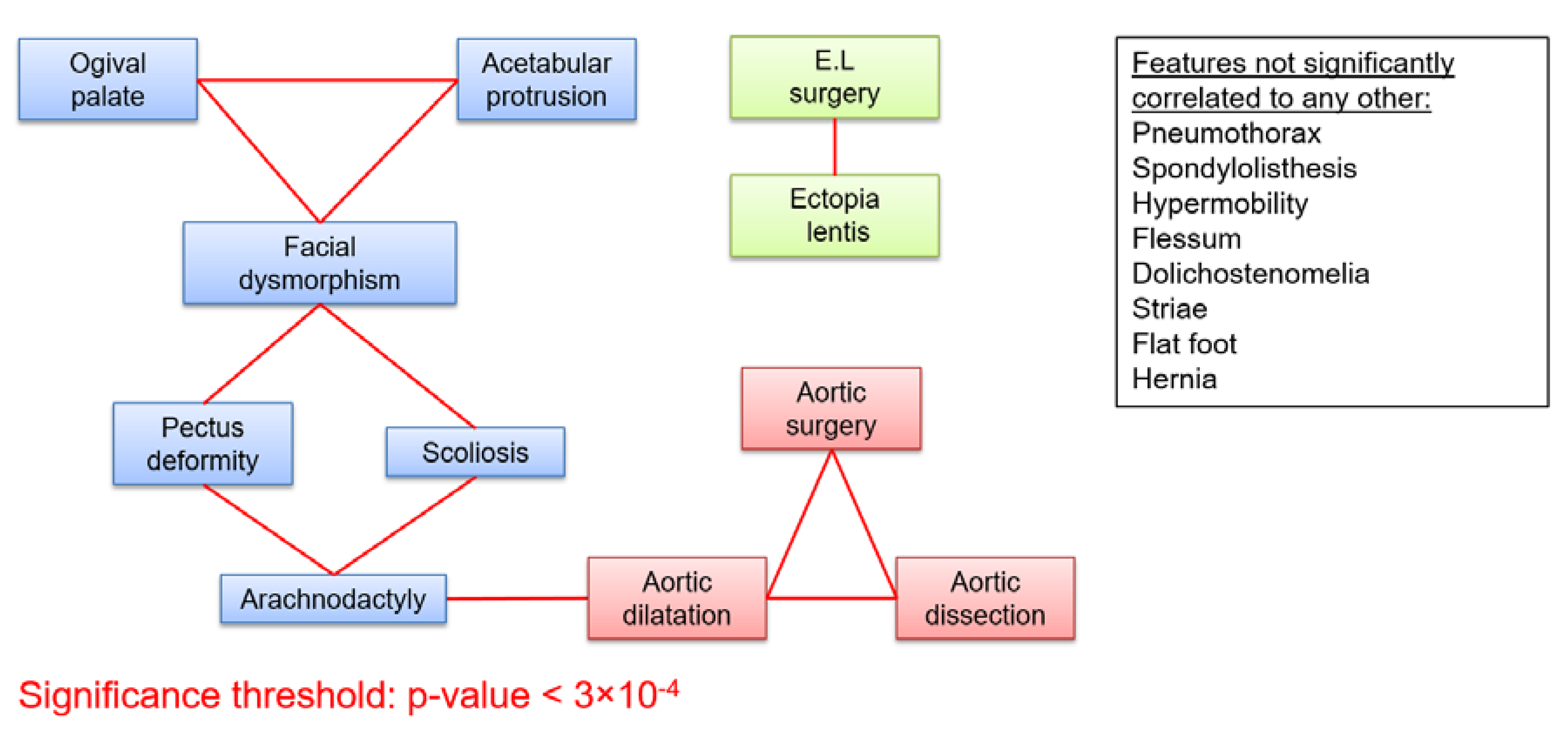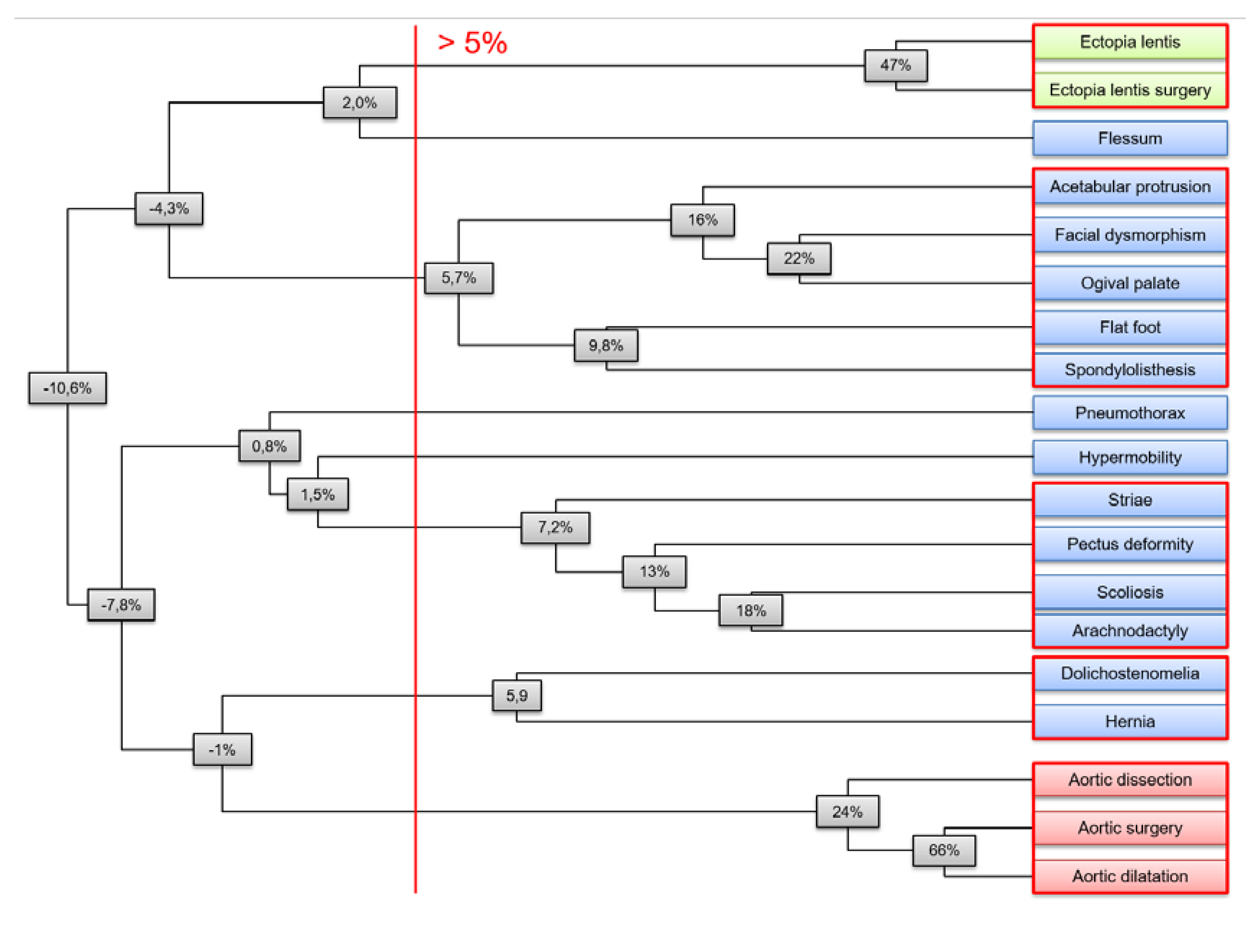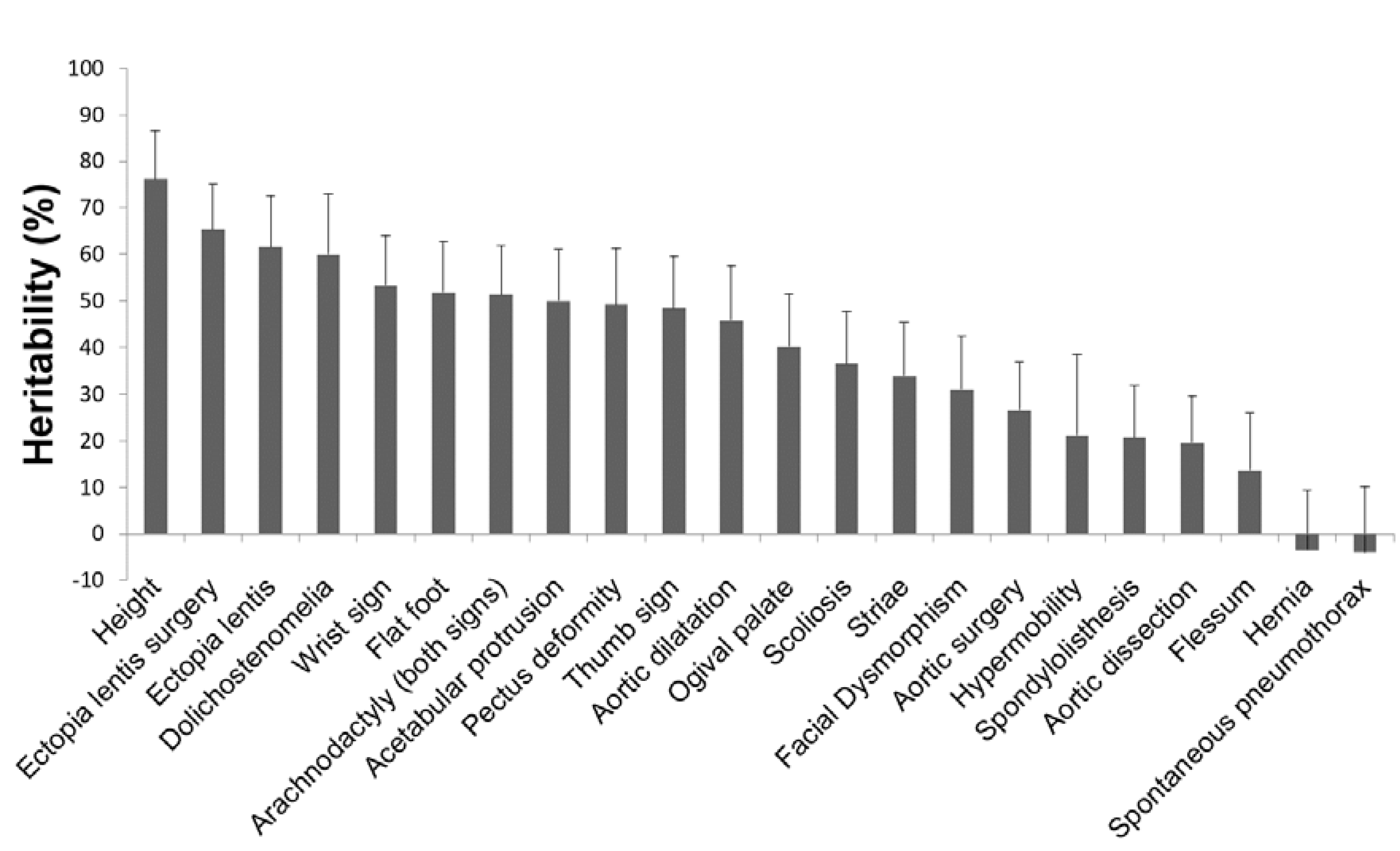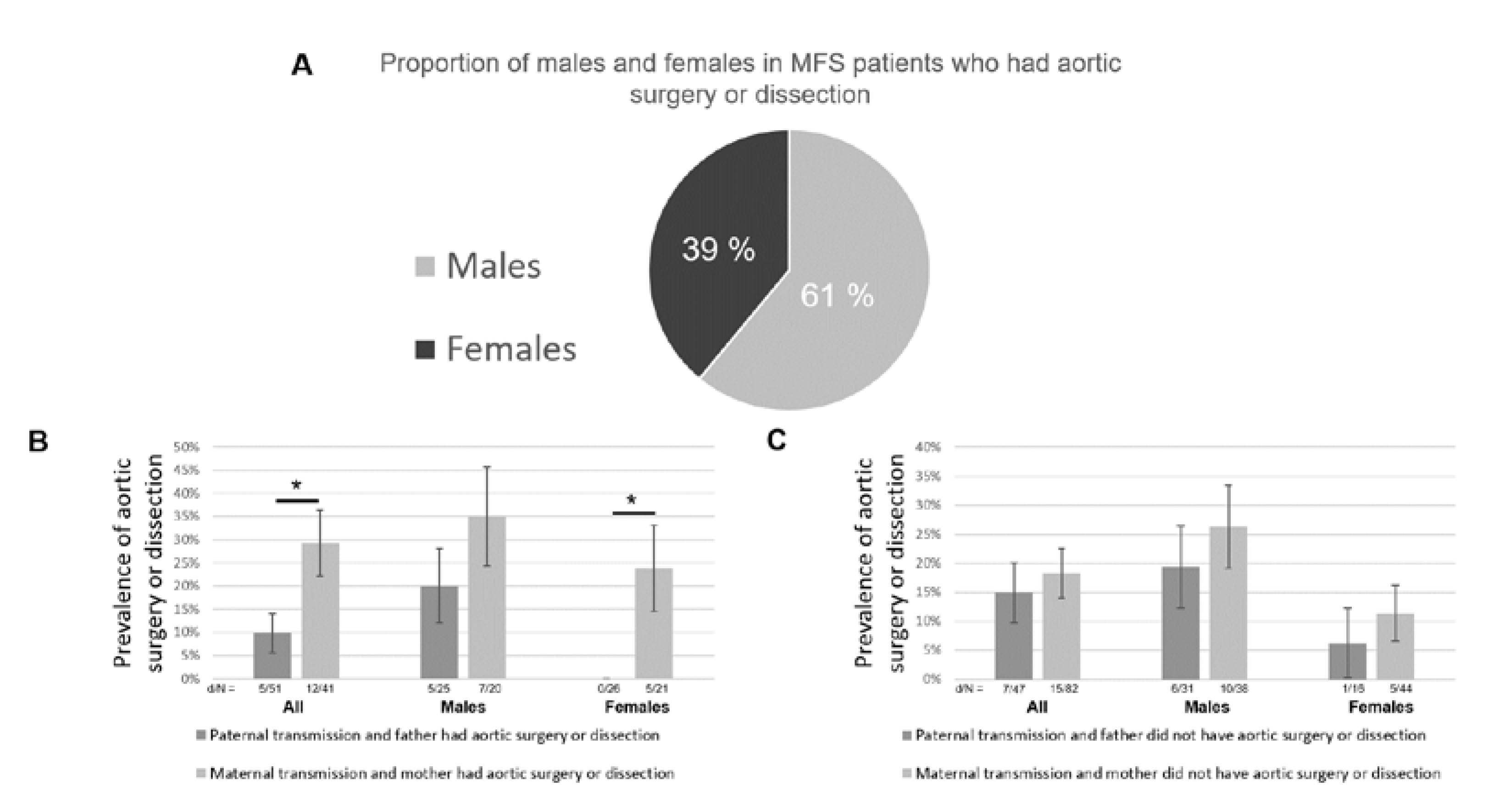Quantifying the Genetic Basis of Marfan Syndrome Clinical Variability
Abstract
1. Introduction
2. Materials and Methods
2.1. Study Population
2.2. Clinical Features
2.3. Phenotypic Correlations
2.4. Agglomerative Hierarchical Clustering
2.5. Heritability
2.6. Statistical Tests
3. Results
3.1. Cross correlations between Clinical Features and Agglomerative Hierarchical Clustering
3.2. Estimate of Heritability of MFS Features
3.3. H2 FBN1 and H2 non-FBN1 Heritability
3.4. Influence of the Sex of the Transmitting Parent and “Carter Effect”
4. Discussion
5. Conclusions
Supplementary Materials
Author Contributions
Funding
Acknowledgments
Conflicts of Interest
References
- Loeys, B.L.; Dietz, H.C.; Braverman, A.C.; Callewaert, B.L.; De Backer, J.; Devereux, R.B.; Hilhorst-Hofstee, Y.; Jondeau, G.; Faivre, L.; Milewicz, D.M.; et al. The revised Ghent nosology for the Marfan syndrome. J. Med. Genet. 2010, 47, 476–485. [Google Scholar] [CrossRef]
- Milleron, O.; Arnoult, F.; Delorme, G.; Detaint, D.; Pellenc, Q.; Raffoul, R.; Tchitchinadze, M.; Langeois, M.; Guien, C.; Beroud, C.; et al. Pathogenic FBN1 Genetic Variation and Aortic Dissection in Patients With Marfan Syndrome. J. Am. Coll. Cardiol. 2020, 75, 843–853. [Google Scholar] [CrossRef] [PubMed]
- Díaz de Bustamante, A.; Ruiz-Casares, E.; Darnaude, M.T.; Perucho, T.; Martínez-Quesada, G. Phenotypic Variability in Marfan Syndrome in a Family With a Novel Nonsense FBN1 Gene Mutation. Revista Española de Cardiología 2012, 65, 380–381. [Google Scholar] [CrossRef] [PubMed]
- Dietz, H.C.; Cutting, G.R.; Pyeritz, R.E.; Maslen, C.L.; Sakai, L.Y.; Corson, G.M.; Puffenberger, E.G.; Hamosh, A.; Nanthakumar, E.J.; Curristin, S.M. Marfan syndrome caused by a recurrent de novo missense mutation in the fibrillin gene. Nature 1991, 352, 337–339. [Google Scholar] [CrossRef] [PubMed]
- Michel, J.-B.; Jondeau, G.; Milewicz, D.M. From genetics to response to injury: Vascular smooth muscle cells in aneurysms and dissections of the ascending aorta. Cardiovasc. Res. 2018, 114, 578–589. [Google Scholar] [CrossRef]
- De Backer, J.; Campens, L.; Muiño Mosquera, L. Looking for the Missing Links: Challenges in the Search for Genotype-Phenotype Correlation in Marfan Syndrome. Circ. Genom. Precis. Med. 2018, 11, e002185. [Google Scholar] [CrossRef]
- Franken, R.; Teixido-Tura, G.; Brion, M.; Forteza, A.; Rodriguez-Palomares, J.; Gutierrez, L.; Garcia Dorado, D.; Pals, G.; Mulder, B.J.; Evangelista, A. Relationship between fibrillin-1 genotype and severity of cardiovascular involvement in Marfan syndrome. Heart 2017, 103, 1795–1799. [Google Scholar] [CrossRef]
- Takeda, N.; Inuzuka, R.; Maemura, S.; Morita, H.; Nawata, K.; Fujita, D.; Taniguchi, Y.; Yamauchi, H.; Yagi, H.; Kato, M.; et al. Impact of Pathogenic FBN1 Variant Types on the Progression of Aortic Disease in Patients With Marfan Syndrome. Circ. Genom. Precis. Med. 2018, 11, e002058. [Google Scholar] [CrossRef]
- Faivre, L.; Collod-Beroud, G.; Loeys, B.L.; Child, A.; Binquet, C.; Gautier, E.; Callewaert, B.; Arbustini, E.; Mayer, K.; Arslan-Kirchner, M.; et al. Effect of mutation type and location on clinical outcome in 1,013 probands with Marfan syndrome or related phenotypes and FBN1 mutations: An international study. Am. J. Hum. Genet. 2007, 81, 454–466. [Google Scholar] [CrossRef]
- Faivre, L.; Collod-Beroud, G.; Callewaert, B.; Child, A.; Binquet, C.; Gautier, E.; Loeys, B.L.; Arbustini, E.; Mayer, K.; Arslan-Kirchner, M.; et al. Clinical and mutation-type analysis from an international series of 198 probands with a pathogenic FBN1 exons 24-32 mutation. Eur. J. Hum. Genet. 2009, 17, 491–501. [Google Scholar] [CrossRef]
- Aubart, M.; Gross, M.-S.; Hanna, N.; Zabot, M.-T.; Sznajder, M.; Detaint, D.; Gouya, L.; Jondeau, G.; Boileau, C.; Stheneur, C. The clinical presentation of Marfan syndrome is modulated by expression of wild-type FBN1 allele. Hum. Mol. Genet. 2015, 24, 2764–2770. [Google Scholar] [CrossRef]
- Giusti, B.; Porciani, M.C.; Brunelli, T.; Evangelisti, L.; Fedi, S.; Gensini, G.F.; Abbate, R.; Sani, G.; Yacoub, M.; Pepe, G. Phenotypic variability of cardiovascular manifestations in Marfan SyndromePossible role of hyperhomocysteinemia and C677T MTHFR gene polymorphism. Eur. Heart J. 2003, 24, 2038–2045. [Google Scholar] [CrossRef] [PubMed]
- Stheneur, C.; Tubach, F.; Jouneaux, M.; Roy, C.; Benoist, G.; Chevallier, B.; Boileau, C.; Jondeau, G. Study of phenotype evolution during childhood in Marfan syndrome to improve clinical recognition. Genet. Med. 2014, 16, 246–250. [Google Scholar] [CrossRef] [PubMed]
- Campens, L.; Demulier, L.; De Groote, K.; Vandekerckhove, K.; De Wolf, D.; Roman, M.J.; Devereux, R.B.; De Paepe, A.; De Backer, J. Reference values for echocardiographic assessment of the diameter of the aortic root and ascending aorta spanning all age categories. Am. J. Cardiol. 2014, 114, 914–920. [Google Scholar] [CrossRef] [PubMed]
- Erbel, R.; Aboyans, V.; Boileau, C.; Bossone, E.; Bartolomeo, R.D.; Eggebrecht, H.; Evangelista, A.; Falk, V.; Frank, H.; Gaemperli, O.; et al. 2014 ESC Guidelines on the diagnosis and treatment of aortic diseases: Document covering acute and chronic aortic diseases of the thoracic and abdominal aorta of the adult. The Task Force for the Diagnosis and Treatment of Aortic Diseases of the European Society of Cardiology (ESC). Eur. Heart J. 2014, 35, 2873–2926. [Google Scholar] [CrossRef]
- Elston, R.C.; Gray-McGuire, C. A review of the “Statistical Analysis for Genetic Epidemiology” (S.A.G.E.) software package. Hum. Genom. 2004, 1, 456–459. [Google Scholar] [CrossRef]
- Keen, K.J.; Elston, R.C. Robust asymptotic sampling theory for correlations in pedigrees. Stat. Med. 2003, 22, 3229–3247. [Google Scholar] [CrossRef]
- Mathew, G.; Song, Y.; Elston, R. Interval estimation of familial correlations from pedigrees. Stat. Appl. Genet. Mol. Biol. 2011, 10, 11. [Google Scholar] [CrossRef] [PubMed]
- Hill, W.G.; Mackay, T.F.C.D.S. Falconer and Introduction to quantitative genetics. Genetics 2004, 167, 1529–1536. [Google Scholar] [PubMed]
- Visscher, P.M.; Hill, W.G.; Wray, N.R. Heritability in the genomics era--concepts and misconceptions. Nat. Rev. Genet. 2008, 9, 255–266. [Google Scholar] [CrossRef]
- Carter, C.O.; Evans, K.A. Inheritance of congenital pyloric stenosis. J. Med. Genet. 1969, 6, 233–254. [Google Scholar] [CrossRef] [PubMed]
- Détaint, D.; Faivre, L.; Collod-Beroud, G.; Child, A.H.; Loeys, B.L.; Binquet, C.; Gautier, E.; Arbustini, E.; Mayer, K.; Arslan-Kirchner, M.; et al. Cardiovascular manifestations in men and women carrying a FBN1 mutation. Eur. Heart J. 2010, 31, 2223–2229. [Google Scholar] [CrossRef] [PubMed]
- De Paepe, A.; Devereux, R.B.; Dietz, H.C.; Hennekam, R.C.; Pyeritz, R.E. Revised diagnostic criteria for the Marfan syndrome. Am. J. Med. Genet. 1996, 62, 417–426. [Google Scholar] [CrossRef]
- Dempster, E.R.; Lerner, I.M. Heritability of Threshold Characters. Genetics 1950, 35, 212–236. [Google Scholar] [PubMed]
- Pyeritz, R.E. Marfan syndrome: 30 years of research equals 30 years of additional life expectancy. Heart 2009, 95, 173–175. [Google Scholar] [CrossRef]
- Aubart, M.; Gazal, S.; Arnaud, P.; Benarroch, L.; Gross, M.-S.; Buratti, J.; Boland, A.; Meyer, V.; Zouali, H.; Hanna, N.; et al. Association of modifiers and other genetic factors explain Marfan syndrome clinical variability. Eur. J. Hum. Genet. 2018, 26, 1759–1772. [Google Scholar] [CrossRef]
- Joergensen, T.M.M.; Christensen, K.; Lindholt, J.S.; Larsen, L.A.; Green, A.; Houlind, K. Editor’s Choice—High Heritability of Liability to Abdominal Aortic Aneurysms: A Population Based Twin Study. Eur. J. Vasc. Endovasc. Surg. 2016, 52, 41–46. [Google Scholar] [CrossRef]
- Larsson, E.; Granath, F.; Swedenborg, J.; Hultgren, R. A population-based case-control study of the familial risk of abdominal aortic aneurysm. J. Vasc. Surg. 2009, 49, 47–50; discussion 51. [Google Scholar] [CrossRef]
- Cooke, R.M.; Wilkinson, A.J.; Baron, M.; Pastore, A.; Tappin, M.J.; Campbell, I.D.; Gregory, H.; Sheard, B. The solution structure of human epidermal growth factor. Nature 1987, 327, 339–341. [Google Scholar] [CrossRef]
- Sabbagh, A.; Pasmant, E.; Laurendeau, I.; Parfait, B.; Barbarot, S.; Guillot, B.; Combemale, P.; Ferkal, S.; Vidaud, M.; Aubourg, P.; et al. Unravelling the genetic basis of variable clinical expression in neurofibromatosis 1. Hum. Mol. Genet. 2009, 18, 2768–2778. [Google Scholar] [CrossRef]




| Parent–Offspring | Siblings | Heritability (H2%, ± S D) | |||
|---|---|---|---|---|---|
| Correlation (%, ± SD) | Sample Size (n) | Correlation (%, ± SD) | Sample Size (n) | ||
| Height | 37.4 ± 6.7 | 193 | 38.8 ± 8.0 | 155 | 76.2 ± 10.4 |
| Ectopia lentis surgery | 35.8 ± 6.5 | 183 | 29.5 ± 7.4 | 162 | 65.3 ± 9.9 |
| Ectopia lentis | 32.5 ± 6.6 | 184 | 29.1 ± 8.9 | 163 | 61.6 ± 11.1 |
| Dolichostenomelia | 27.8 ± 9.2 | 142 | 32.3 ± 9.2 | 118 | 60.1 ± 13.0 |
| Wrist sign | 21.5 ± 6.9 | 193 | 31.8 ± 8.3 | 173 | 53.3 ± 10.8 |
| Flat foot | 22.0 ± 7.0 | 185 | 30.0 ± 8.5 | 163 | 51.9 ± 11.0 |
| Arachnodactyly | 19.7 ± 6.8 | 192 | 31.6 ± 8.2 | 170 | 51.3 ± 10.6 |
| Protrusio acetabulae | 24.6 ± 7.5 | 164 | 25.3 ± 8.3 | 132 | 50.0 ± 11.2 |
| Pectus deformity | 13.1 ± 8.0 | 187 | 36.2 ± 9.1 | 163 | 49.3 ± 12.1 |
| Thumb sign | 19.8 ± 6.9 | 188 | 28.6 ± 8.8 | 166 | 48.4 ± 11.2 |
| Aortic dilatation | 22.8 ± 8.2 | 184 | 23.0 ± 8.6 | 147 | 45.8 ± 11.8 |
| Ogival palate | 27.2 ± 6.5 | 187 | 13.0 ± 9.4 | 166 | 40.1 ± 11.4 |
| Scoliosis | 20.2 ± 7.1 | 185 | 16.4 ± 8.6 | 163 | 36.6 ± 11.2 |
| Striae | 12.9 ± 7.0 | 192 | 21.0 ± 9.2 | 171 | 33.9 ± 11.6 |
| Facial dysmorphism | 11.0 ± 6.8 | 188 | 20.0 ± 9.4 | 162 | 31.0 ± 11.6 |
| Aortic surgery | 6.8 ± 6.1 | 265 | 19.8 ± 8.2 | 222 | 26.6 ± 10.2 |
| Hypermobility | −8.1 ± 11.3 | 183 | 29.3 ± 13.2 | 168 | 21.2 ± 17.4 |
| Spondylolisthesis | 15.3 ± 7.6 | 154 | 5.4 ± 8.3 | 124 | 20.7 ± 11.2 |
| Aortic dissection | −2.5 ± 7.1 | 265 | 22.0 ± 7.2 | 222 | 19.5 ± 10.1 |
| Flessum | 11.1 ± 7.9 | 174 | 2.6 ± 9.6 | 166 | 13.6 ± 12.4 |
| Hernia | −0.8 ± 6.9 | 177 | −2.7 ± 10.9 | 157 | −3.5 ± 12.9 |
| Pneumothorax | −2.2 ± 6.6 | 192 | −1.8 ± 12.6 | 172 | −4.0 ± 14.2 |
| Parent–Offspring (N ≈ 260) | Siblings (N ≈ 190) | Uncle–Nephew (N ≈ 170) | Cousins (N ≈ 95) | |
|---|---|---|---|---|
| Arachnodactyly | 23% ± 6.2 | 29% ± 7.5 | 8.5% ± 9.1 | 16% ± 19 |
| Ectopia lentis surgery | 41% ± 5.5 | 36% ± 7.4 | 19% ± 14 | 45% ± 12 |
| TAA | 25% ±6.4 | 26% ± 7.7 | 30% ± 9.1 | 13% ± 18 |
© 2020 by the authors. Licensee MDPI, Basel, Switzerland. This article is an open access article distributed under the terms and conditions of the Creative Commons Attribution (CC BY) license (http://creativecommons.org/licenses/by/4.0/).
Share and Cite
Grange, T.; Aubart, M.; Langeois, M.; Benarroch, L.; Arnaud, P.; Milleron, O.; Eliahou, L.; Gross, M.-S.; Hanna, N.; Boileau, C.; et al. Quantifying the Genetic Basis of Marfan Syndrome Clinical Variability. Genes 2020, 11, 574. https://doi.org/10.3390/genes11050574
Grange T, Aubart M, Langeois M, Benarroch L, Arnaud P, Milleron O, Eliahou L, Gross M-S, Hanna N, Boileau C, et al. Quantifying the Genetic Basis of Marfan Syndrome Clinical Variability. Genes. 2020; 11(5):574. https://doi.org/10.3390/genes11050574
Chicago/Turabian StyleGrange, Thomas, Mélodie Aubart, Maud Langeois, Louise Benarroch, Pauline Arnaud, Olivier Milleron, Ludivine Eliahou, Marie-Sylvie Gross, Nadine Hanna, Catherine Boileau, and et al. 2020. "Quantifying the Genetic Basis of Marfan Syndrome Clinical Variability" Genes 11, no. 5: 574. https://doi.org/10.3390/genes11050574
APA StyleGrange, T., Aubart, M., Langeois, M., Benarroch, L., Arnaud, P., Milleron, O., Eliahou, L., Gross, M.-S., Hanna, N., Boileau, C., Gouya, L., & Jondeau, G. (2020). Quantifying the Genetic Basis of Marfan Syndrome Clinical Variability. Genes, 11(5), 574. https://doi.org/10.3390/genes11050574





